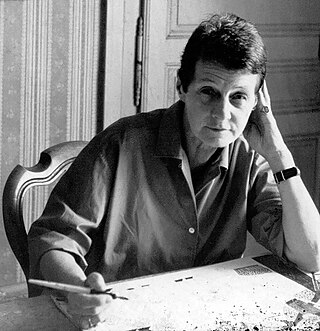Top Qs
Timeline
Chat
Perspective
Véronique Filozof
French painter From Wikipedia, the free encyclopedia
Remove ads
Véronique Filozof (8 August 1904 – 12 January 1977) was a Swiss-born French painter, illustrator, and muralist.[1]
Remove ads
Biography
Summarize
Perspective
Filozof was born Véréna Valérie Sandreuter in Basel on 8 August 1904. [2][3] Her father Rudolf Sandreuter was a blacksmith and musician, and her great-uncle was the painter Hans Sandreuter.[2][4] Filozof was educated at the School of Fine Arts in Basel alongside her sister Élisabeth and her brother Hans.[2]
in 1922, Filozof moved to Troyes in order to improve her French.[5] The following year, in 1923, Filozof married Paul Modin, a school administrator.[6] Filozof and Modin lived in Mulhouse and had two children Paulette and Jean-Guy, before divorcing in 1937. In 1940, Filozof married Georges Filozof (1896–1974), a mining engineer of Polish descent.[2][7][8]
Following the German Occupation of France in June 1940, Filozof fled Mulhouse with her husband and children to Elne, where she became involved with Swiss Red Cross efforts at Maternité Suisse d'Elne.[citation needed] In 1941, Filozof moved to Sarlat-la-Canéda for her husband's work and established a sewing workshop to support local families and the French Resistance network 'Bataillons de la Liberté du Sud'.[citation needed] During this time Filozof formed close ties with the poet Jean Monestier.
In 1946, the family returned to Mulhouse. Filozof began to devote herself to painting, and established an artistic space in her attic.[7] The artistic space, known as 'Le Grenier de Véronique', became a meeting place for the local post-war intelligentsia.[7]
Remove ads
Artistic career
Summarize
Perspective
Filozof's professional artistic career spanned from 1948–1976, with her continuing to produce work up until her death in 1977.[4] In 1948, with encouragement from Pierre Betz, Filozof began to develop her distinctive style.[2] Believing all art in all forms to be interconnected, Filozof started to incorporate quotes and excerpts from poets, writers and philosophers into her artworks .[citation needed] Her first exhibition, held in October 1949 at the Galerie Rivière in Sarlat-la-Canéda, was well received and praised by art critic George Besson[4]
Filozof was known for her ink drawings and for her mural decorations in both civil and religious settings.[2] Filozof received the Swiss Prize for Best Children's Book twice in 1962 for Les Fables de La Fontaine, and in 1965 for Le Vogelgryff. [citation needed] During her career Filozof set up a studio in Paris [citation needed] and was associated with Paul Éluard, Jean Dubuffet and formed friendships with Aristide Caillaud,[4] Robert Morel and Aurélie Nemours. In the 1960s Filozof was a part of Salon Comparaisons. [citation needed]
Murals
In 1969, Filozof created a seven panel bas-relief mural for then headquarters of the Comité Interprofessionnel Logement Guyenne Gascogne in Bordeaux.[9] Decorating the façade of the Le Médoc office building, the mural depicts iconic elements of Bordeaux's landscape and culture and includes quotes from Simone Weil, Johann Wolfgang von Goethe, Aristote, Jean Cocteau, Montesquieu, Antoine de Saint Exupéry and Gabriel Rosset.[9]
In 1972 Filozof created a fresco in the entrance hall of a kindergarten in Manosque. Filozof created a number of murals for private clients, particularly in Dordogne, Mulhouse, and Basel.[2] A number of Filozof's murals are no longer in existence, including frescoes at a retirement home in The Hague and a series of 15 tapestries for Saint-François d'Assise Hospital in Rotterdam.[2]
In religious architecture, she created a Chemin de Croix (held in a private collection) and a Christmas Nativity Scene, acquired by the State and presented in 1956 at the Chapelle Notre-Dame-du-Haut in Ronchamp. Some surviving works include a marble engraving in the Sacré-Cœur Church in Mulhouse, the stained-glass window La Création in the Cheuge Church in Côte-d'Or (dated 1975),[10] and a mural panel, Jérusalem au temps du Christ, in the Temple Saint-Jean in Mulhouse (1973).[10] Other works have been lost, such as the seven Calvary scenes created for the church of Plonévez-du-Faou.
Legacy
Following Filozof's death in 1977 a tribute was held at the Théâtre Municipal in Sarlat-la-Canéda.[2] In 1978 tributes were held at the Ecole élémentaire Jules Ferry in Sarlat-la-Canéda, at the Salon d'Art Sacré in Paris and by the Société Industrielle de Mulhouse at the Galerie A.M.C. in Mulhouse. [citation needed]
Filozof's grave at the Cimetière protestant de Mulhouse is engraved with Filozof's illustration of God, and has site patrimonial remarquable protected status.[11] The nursery school "École maternelle publique Véronique Filozof" in Mulhouse, and the Cour Véronique Filozof in Sarlat-la-Canéda are named after Filozof.[12]
Remove ads
Book illustrations
|
Remove ads
Notes
References
Bibliography
External links
Wikiwand - on
Seamless Wikipedia browsing. On steroids.
Remove ads

